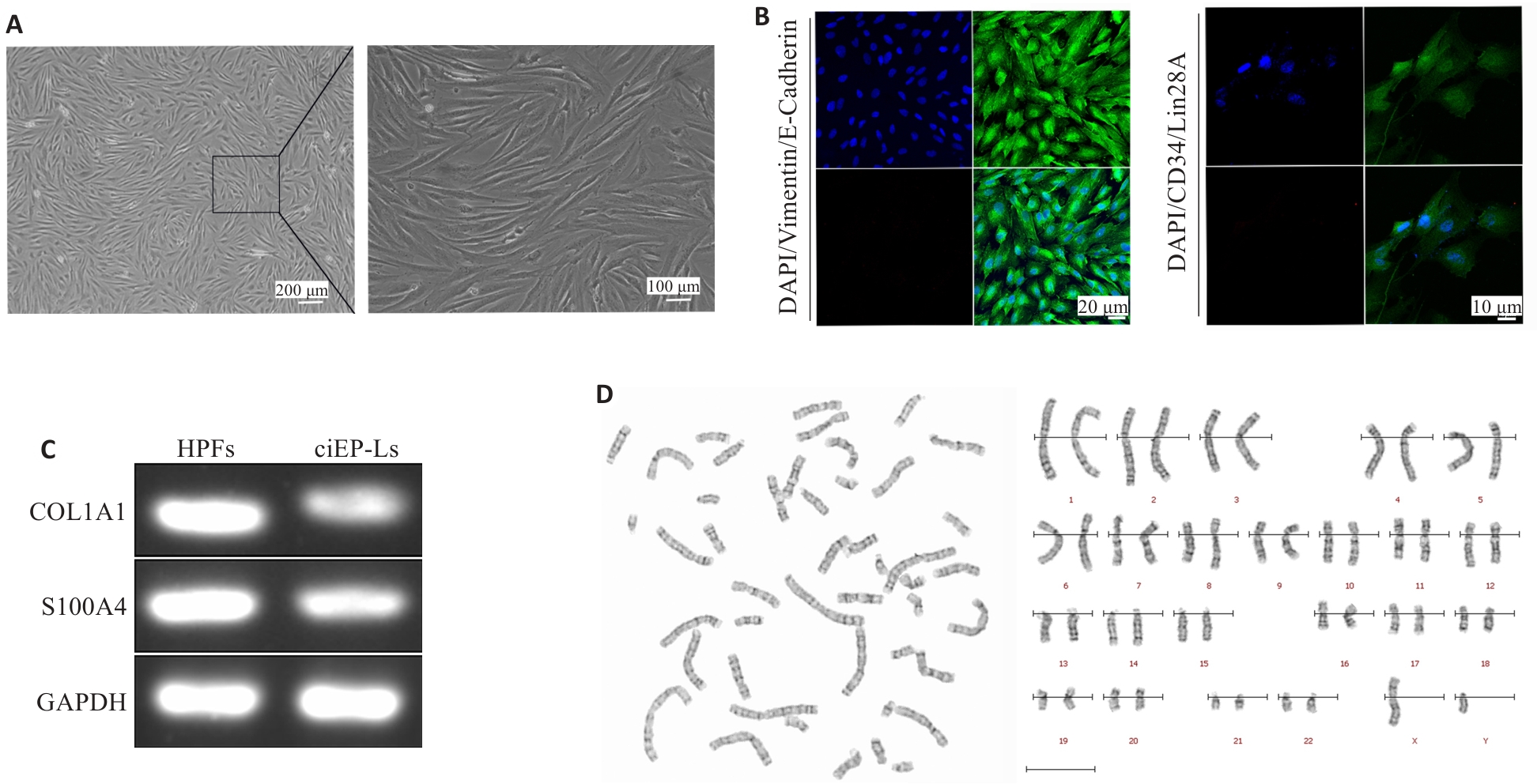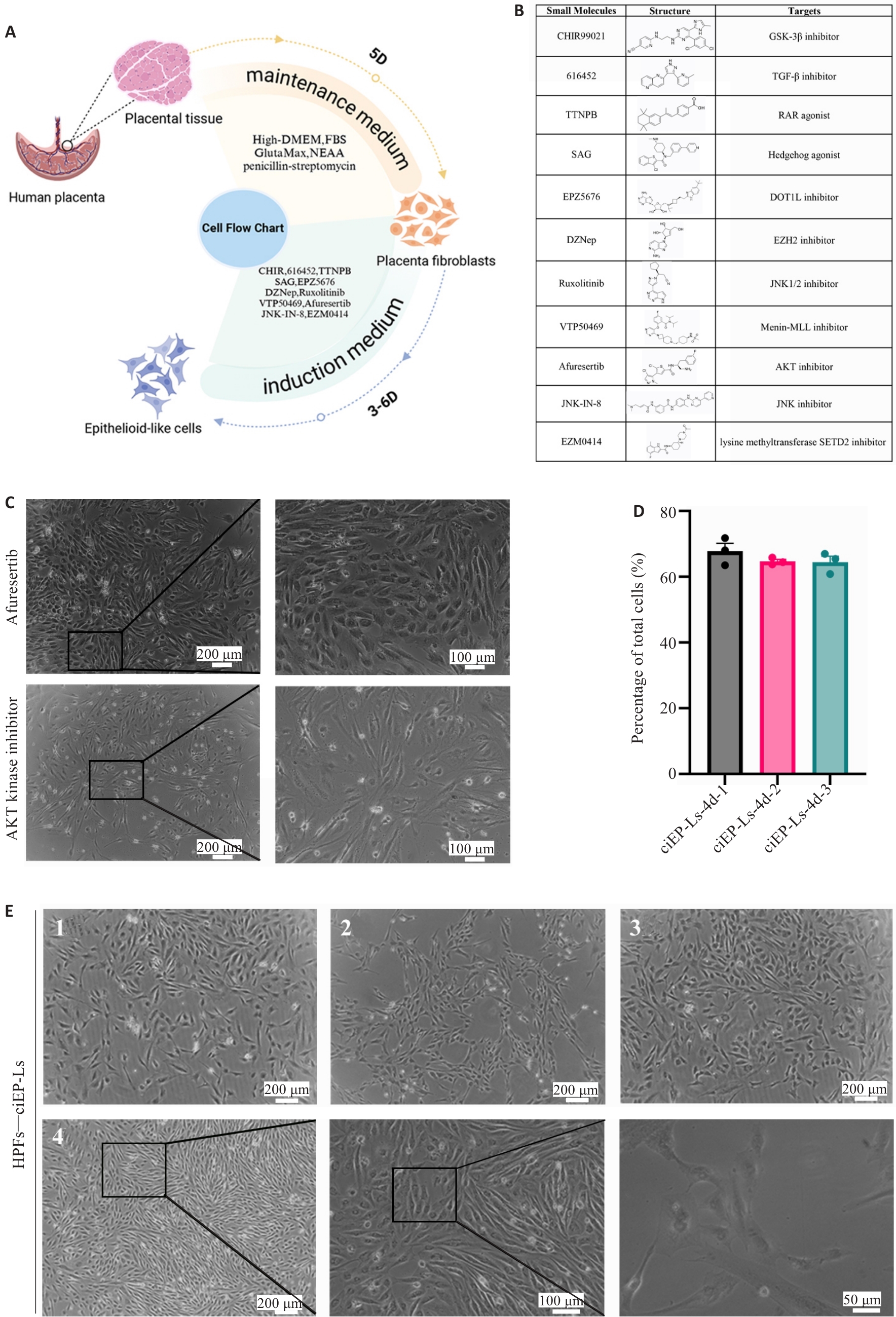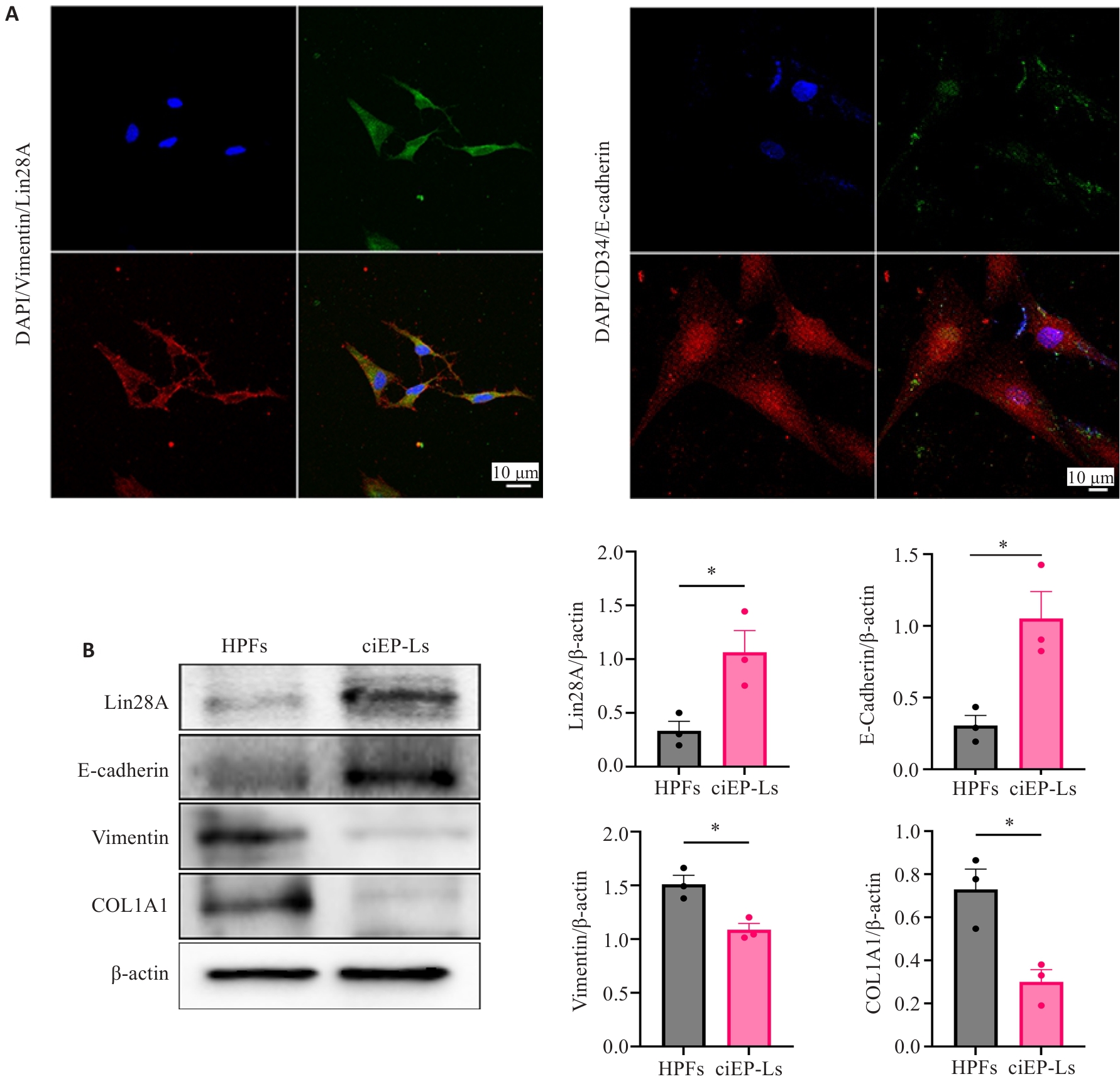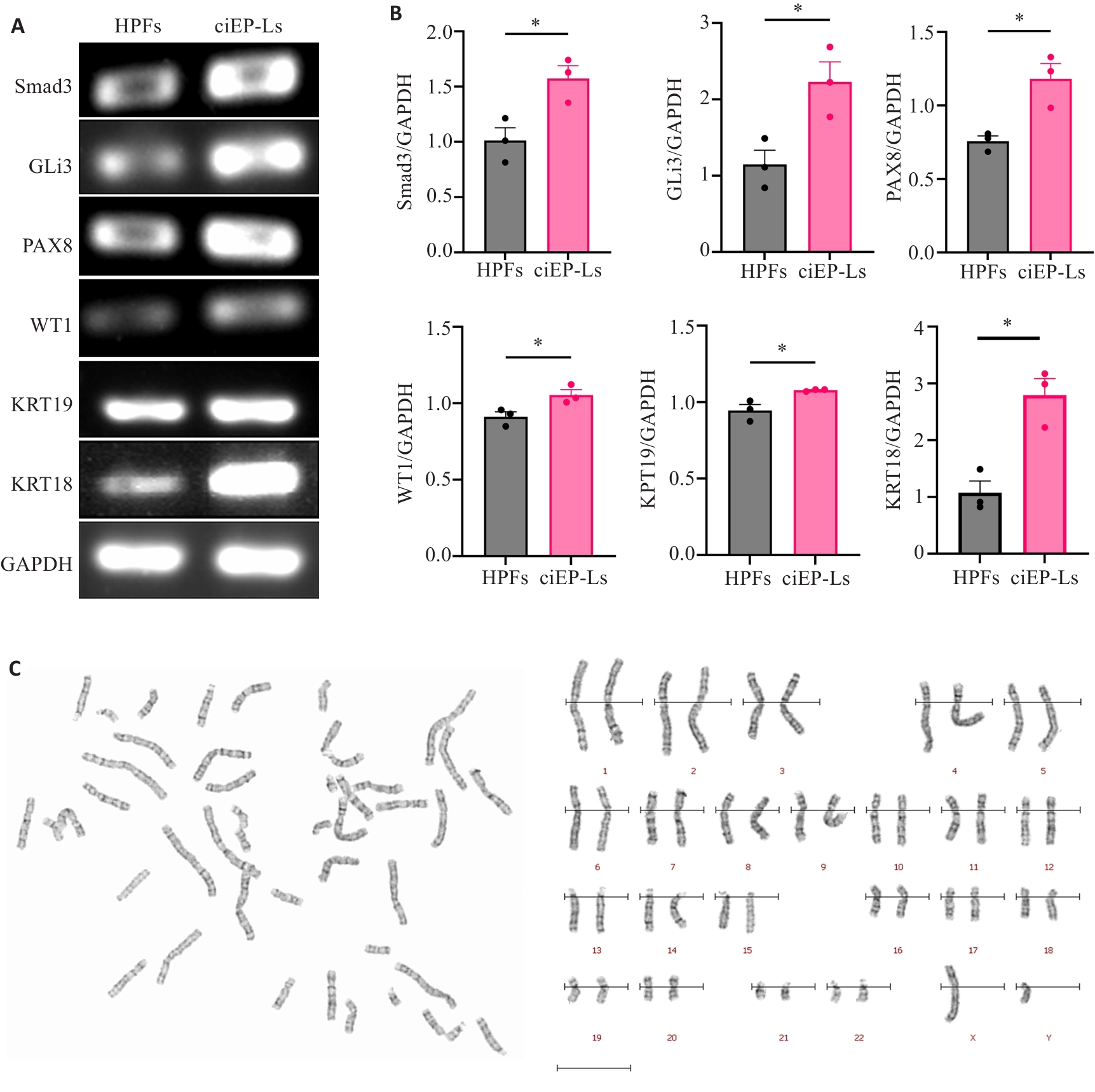Journal of Southern Medical University ›› 2025, Vol. 45 ›› Issue (2): 322-330.doi: 10.12122/j.issn.1673-4254.2025.02.13
Zhenjia DAI1( ), Qunwei GAO1, Mengjiao YING1, Ao WANG1, Juan HONG1, Chunjing WANG1,2, Yu GUO1,3, Changqing LIU1,2, Gaofeng LIU1,2(
), Qunwei GAO1, Mengjiao YING1, Ao WANG1, Juan HONG1, Chunjing WANG1,2, Yu GUO1,3, Changqing LIU1,2, Gaofeng LIU1,2( )
)
Received:2024-08-20
Online:2025-02-20
Published:2025-03-03
Contact:
Gaofeng LIU
E-mail:zjdai000219@163.com;lgfmy@bbmu.edu.cn
Supported by:Zhenjia DAI, Qunwei GAO, Mengjiao YING, Ao WANG, Juan HONG, Chunjing WANG, Yu GUO, Changqing LIU, Gaofeng LIU. C6TSEDRVAJZ, a combination of small-molecule compounds, induces differentiation of human placental fibroblasts into epithelioid cells in vitro[J]. Journal of Southern Medical University, 2025, 45(2): 322-330.
Add to citation manager EndNote|Ris|BibTeX
URL: https://www.j-smu.com/EN/10.12122/j.issn.1673-4254.2025.02.13
| Gene | Primersequence5'-3' |
|---|---|
| COL1A1 | F: GCCAAGACGAAGACATCCCA R: GGCAGTTCTTGGTCTCGTCA |
| S100-A4 | F: TTCTTCCCCTCTCTACAACCCTC R: ATGACAGCAGTCAGGATCAAACC |
| Smad3 | F: TAATTTATTGCCGCCGCTCG R: GGCCATCCAGGGACTCAAAC |
| GLi3 | F: CCGCCGCAGGGCATT R: AACGGCTTTCTCGCTCACAT |
| PAX8 | F: CATTTGAGCGGCAGCACTAC R: AAGGGTGAGTGAGGATCTGC |
| WT1 | F: CAGCGAAAGTTCTCCCGGT R: GCTGAAGGGCTTTTCACCTGTA |
| KRT19 | F: AAATCAGTACGCTGAGGGGC R: GGTTCAATTCTTCAGTCCGGC |
| KRT18 | F: CCTACAAGCCCAGATTGCCA R: TGGTGCTCTCCTCAATCTGC |
| Human GAPDH | F: AATGGGCAGCCGTTAGGAAA R: GCCCAATACGACCAAATCAGAG |
Tab.1 Primer sequences for RT-PCR
| Gene | Primersequence5'-3' |
|---|---|
| COL1A1 | F: GCCAAGACGAAGACATCCCA R: GGCAGTTCTTGGTCTCGTCA |
| S100-A4 | F: TTCTTCCCCTCTCTACAACCCTC R: ATGACAGCAGTCAGGATCAAACC |
| Smad3 | F: TAATTTATTGCCGCCGCTCG R: GGCCATCCAGGGACTCAAAC |
| GLi3 | F: CCGCCGCAGGGCATT R: AACGGCTTTCTCGCTCACAT |
| PAX8 | F: CATTTGAGCGGCAGCACTAC R: AAGGGTGAGTGAGGATCTGC |
| WT1 | F: CAGCGAAAGTTCTCCCGGT R: GCTGAAGGGCTTTTCACCTGTA |
| KRT19 | F: AAATCAGTACGCTGAGGGGC R: GGTTCAATTCTTCAGTCCGGC |
| KRT18 | F: CCTACAAGCCCAGATTGCCA R: TGGTGCTCTCCTCAATCTGC |
| Human GAPDH | F: AATGGGCAGCCGTTAGGAAA R: GCCCAATACGACCAAATCAGAG |

Fig.1 Biological characterization of human placental fibroblasts (HPFs). A: Bright field observation of P3 generation HPFs in normal culture; B: Immunofluorescence detection of CD34, vimnetin, E-Cadherin and Lin28A in HPFs. C: RT-PCR showing the expressions of fibroblast specific genes S100A4 and COL1A1. D: HPFs chromosome G-banding showing chromosomes in metaphase (left) and karyotype (right).

Fig.2 Morphological changes of HPFs during induced differentiation into ciEP-Ls. A: Flowchart of ciEP-Ls induction and differentiation. B: Summary of small molecules used for induced differentiation. C: Morphology of the cells induced for 4 days using afuresertib and AKT kinase inhibitor. D: Analysis of the reprogramming efficiency of the induced cells as a percentage of the total cells calculated from 3 independent experiments. Efficiency (%)=number of induced cells (ciEP-Ls)/number of seeded cells (HPFs)×100%. E: Morphological changes of the cells during induced differentiation.

Fig.3 Western blotting and immunofluorescence identification of ciEP-Ls. A: Immunofluorescence identification of E-Cadherin, Lin28A, CD34, and vimentin expression by ciEP-Ls. B: Western blotting of HPFs and ciEP-Ls proteins. *P<0.05.

Fig.4 PCR, qPCR and karyotype identification of ciEP-Ls. A: RT-PCR detection of ciEP-Ls markers Smad3, GLi3, PAX8, WT1, KRT19 and KRT18. B: Quantitative real-time PCR detection of ciEP-Ls markers Smad3, GLi3, PAX8, WT1, KRT19 and KRT18 (*P<0.05). C: Chromosome G-banding of ciEP-Ls showing chromosomes at the metaphase (left) and the karyotype (right).
| 1 | Willms RJ, Foley E. Mechanisms of epithelial growth and development in the zebrafish intestine[J]. Biochem Soc Trans, 2023, 51(3): 1213-24. |
| 2 | Luo LY, Zhang W, You SY, et al. The role of epithelial cells in fibrosis: Mechanisms and treatment[J]. Pharmacol Res, 2024, 202: 107144. |
| 3 | Kapsimali M. Epithelial cell behaviours during neurosensory organ formation[J]. Development, 2017, 144(11): 1926-36. |
| 4 | Lin H, Cheng Y, Zhang C. Research progress of pulmonary epithelioid hemangioendothelioma[J]. Zhongguo Fei Ai Za Zhi, 2019, 22(7): 470-6. |
| 5 | Takahashi K, Yamanaka S. Induction of pluripotent stem cells from mouse embryonic and adult fibroblast cultures by defined factors[J]. Cell, 2006, 126(4): 663-76. |
| 6 | González F, Boué S, Belmonte JCI. Methods for making induced pluripotent stem cells: reprogramming à la carte[J]. Nat Rev Genet, 2011, 12: 231-42. |
| 7 | Qin H, Zhao AD, Fu XB. Small molecules for reprogramming and transdifferentiation[J]. Cell Mol Life Sci, 2017, 74(19): 3553-75. |
| 8 | Ye J, Ge J, Zhang X, et al. Pluripotent stem cells induced from mouse neural stem cells and small intestinal epithelial cells by small molecule compounds[J]. Cell Res, 2016, 26(1): 34-45. |
| 9 | Liu D, Pavathuparambil Abdul Manaph N, Al-Hawwas M, et al. Small molecules for neural stem cell induction[J]. Stem Cells Dev, 2018, 27(5): 297-312. |
| 10 | Atkins H. Stem cell transplantation to treat multiple sclerosis[J]. JAMA, 2019, 321(2): 153-5. |
| 11 | Schmalzing M, Henes J, van Laar JM, et al. Editorial: Stem cell transplantation in autoimmune diseases (AID)[J]. Front Immunol, 2023, 14: 1150664. |
| 12 | Zhang DD, Wang GD, Qin LS, et al. Restoring mammary gland structures and functions with autogenous cell therapy[J]. Biomaterials, 2021, 277: 121075. |
| 13 | Xu W, Li H, Peng L, et al. Fish pluripotent stem-like cell line induced by small-molecule compounds from caudal fin and its developmental potentiality[J]. Front Cell Dev Biol, 2021, 9: 817779. |
| 14 | Nguyen KN, Bobba S, Richardson A, et al. Native and synthetic scaffolds for limbal epithelial stem cell transplantation[J]. Acta Biomater, 2018, 65: 21-35. |
| 15 | Rosa FF, Pires CF, Kurochkin I, et al. Direct reprogramming of fibroblasts into antigen-presenting dendritic cells[J]. Sci Immunol, 2018, 3(30): eaau4292. |
| 16 | Biddy BA, Kong WJ, Kamimoto K, et al. Single-cell mapping of lineage and identity in direct reprogramming[J]. Nature, 2018, 564: 219-24. |
| 17 | Liuyang SJ, Wang G, Wang YL, et al. Highly efficient and rapid generation of human pluripotent stem cells by chemical reprogramming[J]. Cell Stem Cell, 2023, 30(4): 450-9. e9. |
| 18 | Uko NE, Güner OF, Matesic DF, et al. Akt pathway inhibitors[J]. Curr Top Med Chem, 2020, 20(10): 883-900. |
| 19 | Wu JH, Limmer AL, Narayanan D, et al. The novel AKT inhibitor afuresertib suppresses human Merkel cell carcinoma MKL‐1 cell growth[J]. Clin Exp Dermatol, 2021, 46(8): 1551-4. |
| 20 | Xue WH, Yang L, Chen CX, et al. Wnt/β‑catenin-driven EMT regulation in human cancers[J]. Cell Mol Life Sci, 2024, 81(1): 79. |
| 21 | Lee S, Choi EJ, Cho EJ, et al. Inhibition of PI3K/Akt signaling suppresses epithelial-to-mesenchymal transition in hepatocellular carcinoma through the Snail/GSK-3/beta-catenin pathway[J]. Clin Mol Hepatol, 2020, 26(4): 529-39. |
| 22 | Spencer A, Yoon SS, Harrison SJ, et al. The novel AKT inhibitor afuresertib shows favorable safety, pharmacokinetics, and clinical activity in multiple myeloma[J]. Blood, 2014, 124(14): 2190-5. |
| 23 | Kim Y, Jeong J, Choi D. Small-molecule-mediated reprogramming: a silver lining for regenerative medicine[J]. Exp Mol Med, 2020, 52: 213-26. |
| 24 | Cao S, Yu S, Li D, et al. Chromatin accessibility dynamics during chemical induction of pluripotency[J]. Cell Stem Cell, 2018, 22(4): 529-42. e5. |
| 25 | Duan R, Du W, Guo W. EZH2: a novel target for cancer treatment[J]. J Hematol Oncol, 2020, 13(1): 104. |
| 26 | Ding R, Zheng J, Li N, et al. DZNep, an inhibitor of the histone methyltransferase EZH2, suppresses hepatic fibrosis through regulating miR-199a-5p/SOCS7 pathway[J]. PeerJ, 2021, 9: e11374. |
| 27 | Hou P, Li Y, Zhang X, et al. Pluripotent stem cells induced from mouse somatic cells by small-molecule compounds[J]. Science, 2013, 341(6146): 651-4. |
| 28 | Chase A, Cross NCP. Aberrations of EZH2 in cancer[J]. Clin Cancer Res, 2011, 17(9): 2613-8. |
| 29 | Lin J, Wu Y, Tian G, et al. Menin “reads” H3K79me2 mark in a nucleosomal context[J]. Science, 2023, 379(6633): 717-23. |
| 30 | Alford JS, Lampe JW, Brach D, et al. Conformational-design-driven discovery of EZM0414: a selective, potent SETD2 inhibitor for clinical studies[J]. ACS Med Chem Lett, 2022, 13(7): 1137-43. |
| 31 | Guan JY, Wang G, Wang JL, et al. Chemical reprogramming of human somatic cells to pluripotent stem cells[J]. Nature, 2022, 605: 325-31. |
| 32 | Maherali N, Hochedlinger K. Tgfbeta signal inhibition cooperates in the induction of iPSCs and replaces Sox2 and cMyc[J]. Curr Biol, 2009, 19(20): 1718-23. |
| 33 | Zhao XX, An XL, Zhu XC, et al. Inhibiting transforming growth factor-β signaling regulates in vitro maintenance and differentiation of bovine bone marrow mesenchymal stem cells[J]. J Exp Zool B Mol Dev Evol, 2018, 330(8): 406-16. |
| 34 | Zhang YE. Non-smad pathways in TGF-beta signaling[J]. Cell Res, 2009, 19(1): 128-39. |
| 35 | Zheng J, Dai Q, Han K, et al. JNK-IN-8, a c-Jun N-terminal kinase inhibitor, improves functional recovery through suppressing neuroinflammation in ischemic stroke[J]. J Cell Physiol, 2020, 235(3): 2792-9. |
| 36 | Zhao M, Chen S, Yang ML, et al. Vitamin A regulates neural stem cell proliferation in rats after hypoxic-ischemic brain damage via RARɑ-mediated modulation of the β-catenin pathway[J]. Neurosci Lett, 2020, 727: 134922. |
| 37 | Janesick A, Wu SC, Blumberg B. Retinoic acid signaling and neuronal differentiation[J]. Cell Mol Life Sci, 2015, 72(8): 1559-76. |
| 38 | Jin Y, Teh SS, Lau HLN, et al. Retinoids as anti-cancer agents and their mechanisms of action[J]. Am J Cancer Res, 2022, 12(3): 938-60. |
| 39 | Das M, Pethe P. Differential expression of retinoic acid alpha and beta receptors in neuronal progenitors generated from human embryonic stem cells in response to TTNPB (a retinoic acid mimetic)[J]. Differentiation, 2021, 121: 13-24. |
| [1] | Jinguang LUO, Huaixiang TAO, Zhiyuan WEN, Long CHEN, Hao HU, Han GUAN. Tumor-associated fibroblasts promotes proliferation and migration of prostate cancer cells by suppressing FBXL3 via upregulating hsa-miR-18b-5p [J]. Journal of Southern Medical University, 2024, 44(7): 1284-1296. |
| [2] | WANG Zining, YANG Ming, LI Shuanglei, CHI Haitao, WANG Junhui, XIAO Cangsong. A transcriptomic analysis of correlation between mitochondrial function and energy metabolism remodeling in mice with myocardial fibrosis following myocardial infarction [J]. Journal of Southern Medical University, 2024, 44(4): 666-674. |
| [3] | SHAO Shan, BAI Weichao, ZHOU Pengcheng, LUO Minna, ZHAO Xinhan, LEI Jianjun. Metformin suppresses hypoxia-inducible factor-1α expression in cancer-associated fibroblasts to block tumor-stromal cross-talk in breast cancer [J]. Journal of Southern Medical University, 2024, 44(3): 428-436. |
| [4] | Xueyan XI, Ting DENG, Boyu DU. Colorectal fibroblasts promote malignant phenotype of colorectal cancer cells by activating the ERK signaling pathway [J]. Journal of Southern Medical University, 2024, 44(10): 1866-1873. |
| [5] | Ping SHU, Mengke YUAN, Ke YANG, Weizhi HE, Li LIU. Quercetin suppresses pyroptosis in mouse fibroblasts by inhibiting the NLRP3/caspase-1/GSDMD pathway [J]. Journal of Southern Medical University, 2024, 44(10): 1874-1880. |
| [6] | DENG Ting, DU Boyu, XI Xueyan. Colorectal cancer cells induce the formation of cancer-associated fibroblasts by activating the ERK signaling pathway in fibroblasts [J]. Journal of Southern Medical University, 2023, 43(6): 943-951. |
| [7] | YANG Pan, WANG Yuanyuan, GAO Qunwei, LIU Yang, WANG Yi, GUO Yu, LIU Changqing, LIU Gaofeng. Chemical reprogramming of human embryonic fibroblasts into neural progenitor cells in vitro [J]. Journal of Southern Medical University, 2023, 43(3): 360-367. |
| [8] | XIAO Shuzhe, CHENG Yanling, ZHU Yun, TANG Rui, GU Jianbiao, LAN Lin, HE Zhihua, LIU Danqiong, GENG Lanlan, CHENG Yang, GONG Sitang. Fibroblasts overpressing WNT2b cause impairment of intestinal mucosal barrier [J]. Journal of Southern Medical University, 2023, 43(2): 206-212. |
| [9] | LI Jingjuan, LI Fanfan, NIU Lu, AN Binbin, CHENG Xiaoqiong, LIU Yuanyuan, WANG Jinyang. Smeglutide inhibits high glucose-induced proliferation of myocardial fibroblasts by downregulating TGFβ/Smad3 signaling [J]. Journal of Southern Medical University, 2023, 43(11): 1935-1940. |
| [10] | HUANG Yongqi, YU Wei, YOU Yuehua. Arecoline induces activation of human oral fibroblasts by promoting macrophage secretion of exosomes containing miR-155-5p [J]. Journal of Southern Medical University, 2023, 43(1): 60-67. |
| [11] | WEN Jun, ZHU Huimin, LI Xuemei, HUANG Jiagui, CHEN Yue, YANG Qin. Inhibition of Sonic Hedgehog signaling inhibits fibrous scar formation and adversely affects functional outcome after ischemic brain injury in rats [J]. Journal of Southern Medical University, 2022, 42(6): 840-848. |
| [12] | LI Shuyu, YANG Qixin, ZUO Anna, TIAN Linhua, HUO Jinhai, MENG Yanli, TANG Qingfa, WANG Weiming. Preparation of purified proteins from fresh Pheretima and their inhibitory effect against pulmonary fibrosis in mice [J]. Journal of Southern Medical University, 2022, 42(4): 618-624. |
| [13] | WEN Jun, ZHU Huimin, LI Xuemei, HUANG Jiagui, CHEN Yue, YANG Qin. Transforming growth factor-β1 induces transformation of rat meningeal fibroblasts into myofibroblasts by upregulating Shh signaling [J]. Journal of Southern Medical University, 2022, 42(2): 250-255. |
| [14] | WANG Lulin, WANG Yuan, LIU Jian, HUANG Chuanbing, ZHANG Wandong, WAN Lei, SUN Yue, HUANG Dan. Effects of serum from Xinfeng capsule-treated rats on lipopolysaccharide-induced pyroptosis in rheumatoid arthritis synovial fibroblasts [J]. Journal of Southern Medical University, 2022, 42(12): 1846-1851. |
| [15] | . Gene expression profiles of myopic mouse scleral fibroblasts: a bioinformatics analysis based on single-cell RNA sequencing [J]. Journal of Southern Medical University, 2021, 41(7): 1087-1092. |
| Viewed | ||||||
|
Full text |
|
|||||
|
Abstract |
|
|||||